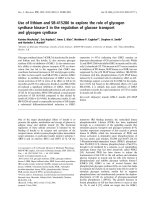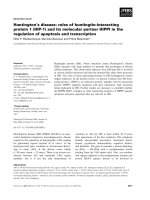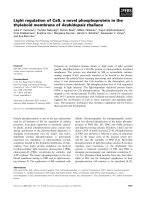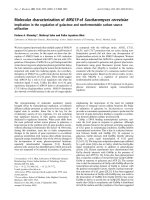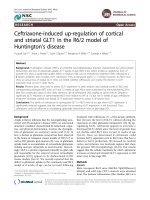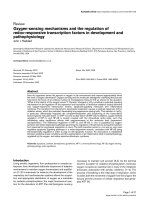Regulation of navigation and vessel-source pollution in the Northern Sea Route - Article 234 and state practice
Bạn đang xem bản rút gọn của tài liệu. Xem và tải ngay bản đầy đủ của tài liệu tại đây (193.2 KB, 23 trang )
10 Regulation of navigation and vessel-source
pollution in the Northern Sea Route: Article
234 and state practice
.
The seaway known as the Northern Sea Route (NSR), which passes
through the ice-infested waters of the Russian Arctic, can potentially halve the dis-
tance between Europe and northeast Asia. A voyage between Hamburg and
Yokohama would be only 6,600 miles
1
if the NSR is chosen, in comparison to 11,400
miles through the Suez Canal. The NSR itself covers between 2,200 and 2,900 miles
of often ice-covered waters.
2
Russia has put considerable efforts into developing the infrastructure for
marine transport along the NSR. In the changing geo-political picture of the Arctic
in the post-Cold War era,
3
Russia officially opened the NSR for foreign vessels in
1991. However, various factors, not least the difficult ice conditions, have so far pre-
vented it from becoming widely used by international shipping.
Unlike most other sea routes, there is no single, set channel: ice condi-
tions at any one place decide the further course. The NSR crosses a series of indi-
vidual seas – the Kara, Laptev, East Siberian and Chukchi Seas – which in turn are
linked by almost sixty straits running through archipelagos including Novaya
Zemlya, Severnaya Zemlya and the New Siberian Islands.
Surface vessels may encounter along the NSR natural obstacles of various
kinds. The continental shelf north of Russia is very shallow, in some straits only
8–13 metres. This places absolute limits on the draught of vessels that can navigate.
It is frequently in just those areas with the shallowest depths that the most difficult
ice conditions prevail.
Vessels would navigate the NSR in convoys. The hazards involved in
convoying have been succinctly characterised: ‘Being at sea is risky; being at sea
in ice is twice the risk; being at sea in ice in convoy with an ice-breaker is three
221
1
All references to miles indicate nautical miles.
2
In Russian legal regulation and political perception, the NSR stretches from the northern point of
Novaya Zemlya as well as its straits in the west to the Bering Strait in the east. The actual length of
the NSR in each case depends on ice conditions; see Figure 10.1.
3
See D. Brubaker and W. Østreng, ‘The Military Impact on Regime Formation for the Northern Sea
Route’, in D.Vidas and W. Østreng (eds.), Order for the Oceans at the Turn of the Century (The Hague:
Kluwer Law International, 1999), pp. 261–90.
Figure 10.1 The Northern Sea Route
times the risk.’
4
Consequently, the international shipping community has thus far
never seriously contemplated acquiring the necessary capability for using the
NSR. Neither has operation of this route seemed feasible, given the economic
preconditions applying in the world market. However, modern technology may
render commercial use of the NSR a real option, with the attendant possible
reductions in commercial shipping expenses that could mean increased rev-
enues.
5
This chapter will analyse the legal regime of navigation applying to the
NSR, which is yet another controversial aspect of any future international use of
this route. We will examine Russian regulations governing navigation and vessel-
source pollution, and the consistency of domestic pr
ovisions with current interna-
tional law. The latter includes Article 234 of the 1982 United Nations Convention
on the Law of the Sea
6
(the LOS Convention), as well as other relevant treaty law
provisions and customary law. Russian legislative pr
actice will also be compared
with that of the USA and Canada, which together govern most of the ice-covered
exclusive economic zones in the Arctic. The aim is to demonstrate how the state
practice, including legislation, of relevant Arctic states has been shaping the con-
tours of Article 234.
:
It has been observed that:
For decades, the NSR has been one of the most contentious legal and political
issues in US–Soviet/Russian Arctic relations. A major concern relates to the
effects the NSR may have on the Arctic environment.
7
Article 234 of the LOS Convention states:
8
CoastalStateshavetherighttoadoptandenforcenon-discriminatorylaws and
regulationsfor the prevention, reductionand control of marine pollution from
vessels in ice-covered areas within the limits of the exclusive economic zone,
where particularlysevere climatic conditions and the presence of ice covering
such areas for most of the year create obstructions or exceptional hazards to
navigation, and pollution of the marine environment could cause major harm
to or irreversible disturbance of the ecological balance. Such laws and regula-
tions shall have due regard to navigation and the protection and preservation
of the marine environment based on the best available scientific evidence.
Navigation and pollution in the Northern Sea Route 223
4
G. Watson, ‘Technical Aspects of Ice Navigation and Port Construction in Soviet Arctic’, in L.
Brigham (ed.), The Soviet Maritime Arctic (London: Belhaven Press, 1991), p. 159.
5
T. Ramsland and S. Hedels, ‘The NSR Transit Study (Part IV): The Economics of the NSR. A
Feasibility Study of the NSR as an Alternative to the International Shipping Market’, INSROP
Working Paper, No. 59 (Lysaker: Fridtjof Nansen Institute, 1996).
6
Text reprinted in ILM, Vol. 21, 1982, pp. 1,261ff.
7
A. Roginko, ‘Environmental Protection in the Soviet Arctic Seas’, in Brigham (ed.), The Soviet
Maritime Arctic, pp. 63–82.
8
On Art. 234, see also Vukas, Chapter 2 in this book, as well as Rothwell and Joyner, Chapter 7 in this
book.
Canada, the USSR and the USA negotiated Article 234 at the Third UN Conference
on the Law of the Sea.
9
Of these three, to date (8 June 1999) only Russia has ratified
the LOS Convention. This adds to the complexity of the legal picture concerning
the scope of Article 234 regarding the NSR. Russia is bound by Article 234 as treaty
law. The USA has expressly acknowledged Part XII of the LOS Convention, which
also includes Article 234, as customary law.
10
Canada is neither a party to the LOS
Convention nor has it expressly acknowledged its Part XII as customary law. All
three states have, however, adopted relevant domestic legislation and made
various declarations, which will be analysed below.
While it may be uncertain whether the entire Part XII is already custom-
ary law,
11
it is important to realise that the Convention’s regime for prevention of
vessel-source pollution
12
incorporates the rules found in MARPOL 73/78,
13
and as
such may be applied by all three states in the EEZ.
Russia claims its entire Arctic EEZ, and possibly the high seas, to be
subject to special coastal state rights for ice-covered areas. It further claims that
ice-covered straits of the NSR are part of its internal waters, supporting this by
several theories, including that of historic waters enclosed by straight baselines.
14
The USA, through its declarations and submerged navigation, has
remained opposed to features of the Russian regime for ice-covered areas govern-
ing the NSR. While the USA does accept an extensive coastal state prescriptive and
enforcement jurisdiction for ice-covered areas, it has reserved its position with
regard to ice-covered straits, equally so regarding those in the Russian and
Canadian Arctic.
15
In the US view, the Russian Arctic straits are international and
thus subject to transit passage.
16
In addition, US declar
ations have included pro-
tests against Russian Arctic baselines and objections to the application of the
Russian legislation for the NSR to state vessels.
17
Both the USA and Russia invoke national security when substantiating
and warranting their respective stands. The policy of adducing environmental
arguments to restrict foreign shipping seems rather presumptuous, considering
the poor Soviet/Russian environmental record in the area.
18
Russian experts them-
selves have acknowledged the doubtful compliance of the Soviet fleet with strict
224 R. Douglas Brubaker
19
See D. McRae, ‘The Negotiation of Article 234’, in F. Griffiths (ed.), Politics of the Northwest Passage
(Kingston, Ontario: McGill-Queens University Press, 1987), pp. 98–114.
10
Presidential Proclamation No. 5030, Federal Register, Vol. 48, 1983, p. 605 (codified at Code of
Federal Rules, Vol. 3, section 5030).
11
On Part XII and customary law, see the discussion byVukas, Chapter 2 in this book.
12
Arts. 211 and 217–220 of the LOS Convention.
13
See P. W. Birnie and A. E. Boyle, International Law and the Environment (Oxford: Clarendon Press,
1992), pp. 271 and 298–9. On MARPOL 73/78 and polar waters see Rothwell, Chapter 3 in this book.
14
A. Kolodkin and M. Volosov, ‘The Legal Regime of the Soviet Arctic – Major Issues’, Marine Policy,
Vol. 14, 1990, pp. 162–7.
15
On the Canadian Arctic, see also Rothwell and Joyner, Chapter 7 in this book.
16
J. A. Roach and R. W. Smith, Excessive Maritime Claims (Newport, RI: Naval War College, 1994), pp.
48, 58, 200–15 and 227; and interview with J. A. Roach, The Hague, 13 July 1995.
17
Ibid.
18
E. Franckx, Maritime Arctic Claims – Canadian and Russian Perspectives (Dordrecht: Martinus
Nijhoff, 1993), pp. 33–4 and 192–3. On the Soviet/Russian environmental record regarding
dumping of radioactive waste in the Arctic, see Stokke, Chapter 9 in this book.
environmental regulations, as well as the fact that about one-half of the vessel-
source pollution in the Arctic in 1990 was of Soviet origin.
19
: - ,
,
Under Article 234 of the LOS Convention, the conditions for coastal
states’ domestic laws and regulations for ice-covered areas fall within the following
confines. First, their area of application must be ‘within the limits of the EEZ’, where
there are ‘particularly severe climatic conditions and the presence of ice covering
such areas for most of the year’. Secondly, these must be ‘non-discriminatory’ and
aim at preventing, reducing and controlling marine pollution from vessels. Thirdly,
they should have ‘due regard to navigation’ as well as ‘protection and preservation
of the marine environment based on the best available scientific evidence’. Article
234 probably enjoys a broad scope of application due to its vague formulation.
20
In
implementing Article 234, the Soviet Union adopted various legislation. As succes-
sor state to the Soviet Union, Russia has incorporated the entire comprehensive
Soviet legislation, except when contradictory to the Russian Constitution, and has
itself more recently adopted new Arctic legislation.
The 1984 Edict on the Economic Zone of the USSR
21
(Economic Zone
Edict) in Article 14 authorised competent Soviet agencies to:
establish rules for the prevention, reduction, and control of pollution of the
marine environment, as well as for safety of shipping, and ensure the obser-
vance of such rules in ice-covered areas or areas possessing special natural
characteristics where pollution of the marine environment could inflict grave
harm to the ecological balance or irreversibly disturb it.
The 1984 Edict on Intensifying Nature Protection in Areas of the Far North and
Marine Areas Adjacent to the Northern Coast of the USSR
22
(Environmental Edict)
in its Article 3 specified:
In the marine areas adjacent to the northern coast of the USSR where specially
severe climatic conditions and ice hindrances or increased danger for ship-
ping and pollution of the marine environment could cause grave harm to the
ecological balance or irreversiblydisturb it, special navigation rules for vessels
and other floating means shall be established bythe competent Soviet agen-
cies.These rules shall provide for higher construction requirements for vessels
and other floating means, for equipment and supplies, for the complement
Navigation and pollution in the Northern Sea Route 225
19
See R. Vartanov, A. Roginko and V. Kolosov, ‘Russian Security Policy 1945–96: The Role of the Arctic,
the Environment and the NSR’, in W. Østreng (ed.), National Security and International
Environmental Cooperation in the Arctic – The Case of the Northern Sea Route (Dordrecht: Kluwer
Academic Publishers, 1999), pp. 53–102.
20
D. McRae and D. Goundrey, ‘Environmental Jurisdiction in Arctic Waters: The Extent of Article 234’,
University of British Columbia Law Review, Vol. 16, 1982, pp. 215–22.
21
English translation reproduced in W. Butler, The USSR,Eastern Europe and the Development of the
Law of the Sea (London: Oceana, 1987), F. 2, pp. 1ff.
22
English translation reproduced in ibid., J. 4, pp. 1ff.
and skills of the crew, shall prohibit navigation without pilotage or other
escort, shall establish periods and areas closed for navigation, and also other
measures ensuring the safetyof shipping and the prevention, reduction, and
control of pollution of the marine environment. The said rules shall be pub-
lished in Notices to Mariners.
Accordingly, in 1990 the Regulations for Navigation on the Seaways of the Northern
Sea Route (NSR Regulations) were adopted.
23
The objectives are stated in Article 2:
on the basis of non-discrimination for vessels of all States, [to] regulate
navigation through the Northern Sea Route for the purpose of ensuring safe
navigation and preventing, reducing, and keeping under control marine
environment pollution from vessels, since the specifically severe climatic
conditions that exist in the Arctic Regions and the presence of ice during the
larger part of the year bring about obstacles, or increased danger, to naviga-
tion while pollution of sea, or the northern coast of the USSR might cause
great harm to the ecological balance, or upset it irreparably, as well as inflict
damage on the interest and well-being of the peoples of the Extreme North.
The NSR Regulations contain provisions governing mandatory notification and
authorisation to foreign vessels for navigating the NSR (Articles 3 and 8); different
forms of leading along the NSR (Articles 3 and 7(4));
24
special requirements for
vessels and command personnel (Article 4); civil liability (Article 5); inspection
(Article 6); order of navigation (Article 7); control of navigation (Article 8); tempo-
rary suspension of navigation in particular areas of the NSR (Article 9); removal of
vessels off the NSR (Article 10); limitation of liability for the Northern Sea Route
Administration (Article 11); and notification of polluting discharge (Article 12). The
‘special requirements’ refer to technical and operational rates and standards set
forth in publications issued by the Northern Sea Route Administration (NSRA),
including the Guide to Navigating through the Northern Sea Route (NSR
Navigation Guide) and the Requirements for the Design, Equipment and Supplies
of Vessels Navigating the Northern Sea Route (Design Requirements).
25
Important
features of the NSR Regulations include the possibility for application on the high
seas, application to state vessels, mandatory payment of fees, and the introduction
of specially protected areas within ice-covered areas. These features of Russian
legislation need to be examined not only in the light of Article 234 but also in the
light of the relevant practice of other states.
226 R. Douglas Brubaker
23
Regulations were approved by the USSR Minister of Merchant Marine, 14 September 1990.
Russian text published in Izveshcheniya Moreplavatelyam (Notices to Mariners), No. 29, 18 June
1991; English translation, as used in this chapter, published in Guide to Navigating Through the
Northern Sea Route (St Petersburg: Head Department of Navigation and Oceanography, Russian
Ministry of Defence, 1996), pp. 81–4. An English translation is also available, with minor devia-
tions, in International Challenges, Vol. 12, 1992, pp. 121–6. Russia has adopted a plethora of legisla-
tion; however only those provisions considered most central will be discussed.
24
Art. 7(4) lists: (1) leading along recommended routes by shore-based pilotage; (2) aircraft-assisted
leading; (3) conventional pilotage; (4) icebreaker leading; and (5) icebreaker-assisted pilotage.
25
Arts. 1(5) and 4 of the NSR Regulations. English translation of the Guide to Navigating Through
the Northern Sea Route. An English translation of the Design Requirements is in ibid., pp.
317–23.
Legislation governing vessel-source pollution within the Arctic EEZ: ‘due
regard to navigation’
‘Due regard to navigation and the protection and preservation of the
marine environment based on the best available scientific evidence’
26
is an express
condition with which coastal states must comply when they unilaterally adopt and
enforce their laws and regulations governing vessel-source pollution in ice-covered
areas within the limits of the EEZ. These laws and regulations may provide for
design, construction equipment, crewing, discharge and safety standar
ds for
navigation.
Several views exist regarding the meaning of ‘due regard to navigation
[etc.]’ in the context of Article 234, ranging from traditional freedom of navigation
and innocent passage, passage rights in the territorial sea applicable to the EEZ,
passage rights varying according to the status and circumstances of the waters in
question, to extensive coastal state jurisdiction in the EEZ limited only by naviga-
tion upon permit.
27
The first view may likely be the most technically-legally sound. Article 234
expressly restricts its own scope to the EEZ, which under the LOS Convention is
defined as ‘an area beyond and adjacent to the territorial sea’,
28
not extending
‘beyond 200 miles from the baselines’,
29
where all states enjoy, inter alia, the
freedom of navigation.
30
However, it would be absurd to be able to exercise greater rights in the
EEZ than in the territorial sea. Russian legislation, but also that of Canada and the
USA, as will be seen, support the view on extensive coastal state jurisdiction. Most
of the provisions contained in the Russian Arctic legislation far exceed limitations
to innocent passage, and encompass both the territorial sea and the EEZ.
Article 234 aims at preventing, reducing and controlling vessel-source
pollution which can cause ‘major harm to or irreversible disturbance of the ecolog-
ical balance’. A main objective of the Russian provisions is to prevent, reduce and
control vessel-source pollution of its Arctic marine environment, since it might
cause ‘great harm to the ecological balance, or upset it irreparably’ as well as ‘inflict
damage on the interests and well-being of the peoples’ of the Russian Arctic.
31
As
we have seen, Russia has included ‘safety of shipping’ as a goal to environmental
considerations under Article 14 of the Economic Zone Edict and Article 3 of the
Environmental Edict. However, where as a coastal state it has special rights based
on Article 234, the requirement of that Article to have ‘due regard to navigation
[etc.]’ may be questioned.
The NSR Regulations require that the owner or master of a vessel intend-
ing to navigate the NSR submits to the NSRA a notification and a request for
Navigation and pollution in the Northern Sea Route 227
26
This expression will be referred to as ‘due regard to navigation [etc.]’ hereinafter.
27
See A. E. Boyle, ‘Legal Regimes of the Arctic – Remarks’, American Society of International Law
Proceedings, Vol. 82, 1988, pp. 327–8.
28
Art. 55 of the LOS Convention.
29
Ibid., Art. 57.
30
Ibid., Art. 58(1).
31
Art. 2 of the NSR Regulations.
leading,
32
and that the vessel satisfy the special requirements.
33
The NSRA shall
then consider this application and inform of the possibility of leading through the
NSR,
34
which implies authorisation of navigation. These requirements are clearly
contrary to Articles 17 and 58 of the LOS Convention, guaranteeing innocent
passage in the territorial sea and freedom of navigation in the EEZ, respectively.
They may, however, arguably be permitted under a broad interpretation of ‘due
regard to navigation [etc.]’, due to the dangers of navigation in ice-infested waters.
Leading, especially in ice-bound straits, as required under Article 7(4) of
the NSR Regulations, seems reasonable and gives substance to preventing, reduc-
ing and controlling vessel-source pollution.
35
However, the NSR Regulations also
seem to allow for the possibility of complete prohibition of navigation. This may be
deduced from the vaguely phrased passage in Article 7(4), which allows the manda-
tory prescription of leading in ‘other regions’, as well as from Article 7(1) which
states that the NSRA will determine the beginning and end of the navigational
period taking into account, inter alia, ‘other conditions’. Article 9, which will be dis-
cussed below, additionally allows for suspension of navigation in cases where ‘an
obvious necessity of environment protection or safe navigation’ so demands. Thus,
due to the open-ended prohibition of navigation without pilotage or other escort
under the NSR Regulations,
36
it seems doubtful whether ‘due regard to navigation
[etc.]’ is actually taken.
Furthermore, the NSR Regulations requir
e mandatory ‘payment for the
services rendered to vessels’,
37
which also may raise a question regarding ‘due
regard to navigation [etc.]’. Under international law, innocent passage may not be
hampered by the coastal state, and neither can charges be levied unless ‘specific
services’ are rendered.
38
Such specific services probably include pilotage or rescue
services, but charges shall be levied without discrimination.
39
For navigation in the
EEZ, charging fees is contrary to freedom of navigation, and may be subject only to
pollution prevention provisions giving effect to and conforming to ‘generally
accepted international rules and standards’.
It may, however, be argued that the fees required under the NSR
Regulations are a necessity for the protection of the marine environment. Pilotage
and rescue services, though applicable to navigation through the EEZ, may be
required by the natural conditions of the NSR. However, for innocent passage
under Article 26 of the LOS Convention fees are allowed only on a case-by-case
basis for ‘specific services rendered to the ship’, and therefore not by reason of mere
passage as such through the territorial sea. It would thus probably be exaggerated
228 R. Douglas Brubaker
32
Ibid., Art. 3(1). This should be in compliance with the form and time stated in the NSR Navigation
Guide.
33
Art. 4 of the NSR Regulations.
34
Ibid., Art. 3(2).
35
Such compulsory ice-breaker assisted pilotage is established under Art. 7(4) of the NSR
Regulations in four straits, due to the adverse navigational situation and ice conditions.
36
See Art. 3 of the Environmental Edict.
37
Art. 8(4) of the NSR Regulations.
38
See Arts. 15(1) and 18(1) of the 1958 Geneva Convention on the Territorial Sea and the Contiguous
Zone (UNTS, Vol. 516, pp. 205ff); and Arts. 24(1) and 26 of the LOS Convention. See the discussion
in R. R. Churchill and A. V. Lowe, The Law of the Sea, 2nd edn (Manchester University Press, 1988),
p. 79.
39
For a discussion concerning discrimination see below in this chapter.
to allow expanded coastal state rights regarding obligatory fees for passage through
an ice-covered EEZ. Services surrounding icebreakers and ice-strengthened
vessels, for which fees could be charged under the NSR Regulations, would likely
not be needed if a relatively ice-free season occurred, as was the case during the
summer of 1995. Since any mandatory blanket fees may in fact serve to prohibit
navigation, their introduction is likely to exceed even a liberal interpretation of ‘due
regard to navigation [etc.]’.
Enforcement measures – including inspections if deemed necessary,
stopping, detention and arrest, suspension if deemed necessary and removal for
violations – apply under the Russian legislation.
40
It may be questioned whether
this strict enforcement of provisions, permitting navigation only in special
instances and largely dependent upon official discretion, does not provide a near
prohibition of navigation.
Casting some doubt upon how genuine is the objective of Arctic environ-
mental protection, upon which the Russian legislation is purportedly based, Article
6 of the Environmental Edict requires a ‘positive ecologically substantiated
opinion’ of authorised agencies for various activities, but not for vessel traffic. It is
only for the construction or renovation of various installations and structures at sea
that an environmental impact assessment (EIA) is required. Similarly, an EIA
requirement is not explicitly included within the scope of Article 4 of the NSR
Regulations, in connection with requirements for vessels, nor is it found in Article
3 of the Environmental Edict, where it conceivably could have been addressed.
Notwithstanding the vague formulations characterising Article 234, the
extent to which ‘due regard to navigation’ is exceeded by the Russian legislation
seems beyond even a liberal interpretation. If, however, the Russian provisions are
compared to the US legislation as a coastal state, nearly all the Russian rules may
be said to fall within similar limits set by the 1990 United States Oil Pollution Act
(OPA) for commercial vessels carrying oil.
41
Similarities are found in the Canadian
legislation as well: the Arctic Waters Pollution Prevention Act (AWPPA)
42
and the
Arctic Shipping Pollution Prevention Regulations (ASPPR).
43
Only a few of the
requirements contained in the Russian legislation actually exceed that of the US
legislation: blanket fees, icebreaker-assisted pilotage and icebreaker leading. The
latter two activities may, however, also be required by Canadian practice in the
Northwest Passage. In 1992, a Canadian ice pilot was on board the Russian vessel
Kapitan Khlebnikov; and a Canadian Coast Guard officer was on board the USCGC
Polar Star in 1988 with the additional accompaniment of the CCGS John A.
Navigation and pollution in the Northern Sea Route 229
40
See Arts. 6 and 10 of the NSR Regulations; Arts. 14 and 15 of the Economic Zone Edict; Arts. 3 and
15 of the Environmental Edict; and Art. 11 of the Decree of the Council of Ministers of the USSR,
1 June 1990, ‘On Measures of Securing the Implementation of the Edict of the Presidium of the
USSR Supreme Soviet of 26 November 1984 “On Intensifying Nature Protection in Areas of the
Extreme North and Marine Areas Adjacent to the Northern Coast of the USSR”’ (1990 Decree); an
English translation is available in E. Franckx, ‘Nature Protection in the Arctic – Recent Soviet
Legislation’, International and Comparative Law Quarterly, Vol. 41, 1992, pp. 377–83.
41
Public Law 101-380, Statutes, Vol. 104, section 484 (1990) (codified at USC, Vol. 33, section 2701).
42
Revised Statutes of Canada, Chapter 2, section A-12. Text reprinted in ILM, Vol. 9, 1970, pp. 598ff.
43
Consolidated Regulations of Canada, 1978, Chapter 356, as amended.



